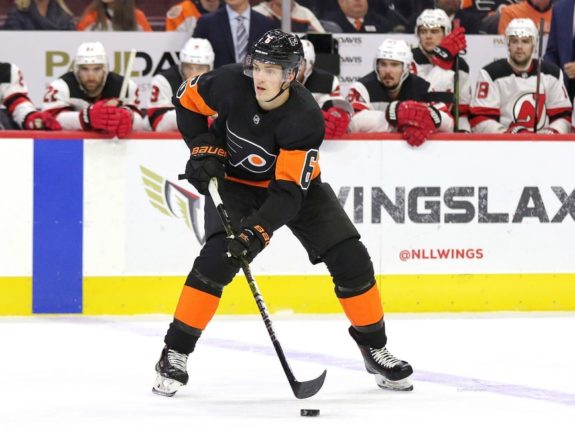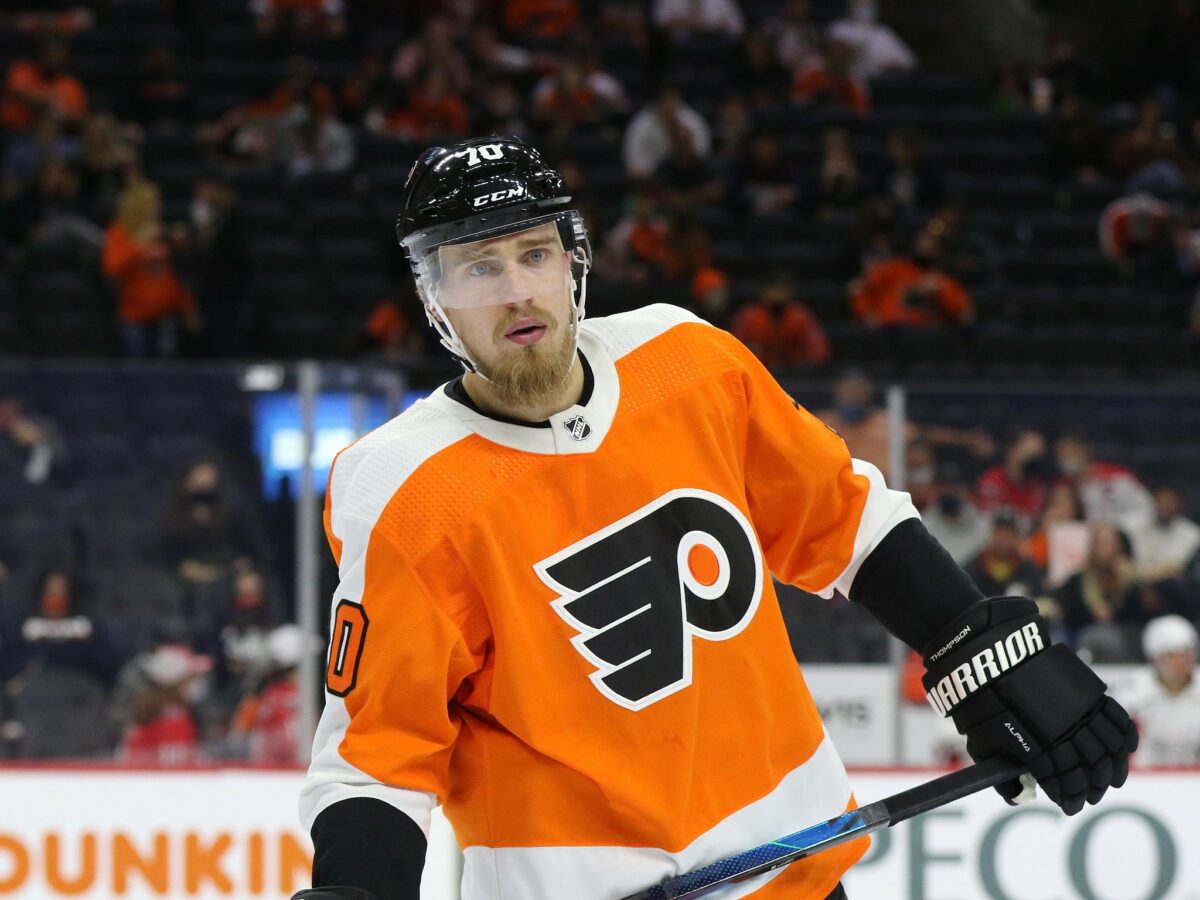Travis Sanheim will enter the 2022-23 season for the Philadelphia Flyers on the final year of his two-year contract signed last summer. Coming off a season when he was unquestionably the best defenseman on the team, he finds himself in an awkward position approaching free agency for an organization with the second-worst salary cap predicament in the NHL (from The Athletic, Ranking every NHL team’s salary cap situation, from best to worst, 7/12/22). General manager (GM) Chuck Fletcher’s lucrative investments in a still underwhelming blue line might force a 26-year-old in his prime out the door as an unrestricted free agent in 2023.
Sanheim’s Standing with the Flyers
Sanheim earned the Barry Ashbee Trophy as the team’s top defenseman and the Pelle Lindbergh Memorial Trophy as the team’s most improved player in 2021-22. He bounced back from a questionable effort in 2020-21 and became the most consistent performer throughout the most disastrous season in franchise history in 2021-22.
The organization views Sanheim as a second-pair defenseman on the left side while they expect Ivan Provorov to man the blue line in the same role on the first pair. However, Sanheim tightened the gap between the two last season when he emphatically outperformed his teammate. While neither respective defenseman graded particularly well in terms of play-driving metrics for a team that spent way too much time in its own end, Sanheim finished with a better expected goals for percentage (xGF%) and Corsi For percentage (CF%) than Provorov.

His size and athleticism have always impressed his proponents, but he progressed his skill set to earn more trust defensively last season. He handled a career-low 38.33% offensive zone starts out of necessity playing on a blue line with some struggling veterans and a shuffled deck of younger players at the end of the season. He has increased his average time on ice (ATOI) shorthanded in each of his five NHL seasons.
Sanheim’s minimal usage on the top pair despite unideal alternative options speaks heavily to the organization’s focus on his fit with righty Rasmus Ristolainen on the second pair, whom Fletcher acquired for an eye-popping package last offseason. The former eight-overall pick of the Buffalo Sabres saw his best career season in 2021-22 in terms of advanced metrics thanks in large part to a solid play-driver like Sanheim next to him. The intensity of a newly-acquired 6-foot-4 bruiser rubbed off on a partner who at previous times shied away from an intense game, especially defending his own crease.
“I thought defensively I was harder to play against. Maybe part of that was because I was playing with Risto (Ristolainen), the physicality he brings and kind of drags you into the fight a little bit. I credit him with helping me on that end and being harder to play against. Maybe not physical but I definitely thought I had a bit more of an edge this season (2021-22).”
-Travis Sanheim
The Flyers clearly value Ristolainen’s physical presence on the blue line despite his lack of significant point production, inconsistency in the defensive zone, and history of subpar grades by advanced metrics. They inked him to a lucrative five-year extension worth $25.5 million in March with the idea of locking him into a strong second pair next to Sanheim. However, the costly long-term investment to sure up a unit with three other contracts of $5 million or more in average annual value (AAV) contributed heavily to the cap predicament in Philadelphia. The decision to lock up Ristolainen might’ve made it a choice between him and his partner, and it’s certainly fair to wonder if the Flyers will ultimately end up with the better of the two.
Fletcher Builds Expensive Blue Line
Provorov, Ristolainen, Tony DeAngelo, and Ryan Ellis will each make $5 million or more in 2022-23 while Sanheim is set to make $4.675 million. Even if the Flyers move their most accomplished defenseman, Ellis, to long-term injured reserve (LTIR) to free up $6.25 million in cap space, the blue line will still take up 30.4% of the team’s cap space.
The only Eastern Conference teams projected to spend a bigger chunk of their salary cap space on defensemen are the Boston Bruins and Pittsburgh Penguins. The Tampa Bay Lightning will put arguably the best defensive corps in the NHL on the ice in 2022-23 using only 27.6% of the team’s cap before long-term extensions for Erik Cernak and Mikhail Sergachev kick in for the 2023-24 season.
Related: Fletcher’s Mismanagement of Flyers’ Defense Proving Very Costly
Fletcher’s misguided allocation of resources is most obvious when looking at Philadelphia’s defensemen. He has made three different trades the past two offseasons that have collectively cost the Flyers more than a full draft’s worth of selections, although the picks are spread throughout four different drafts. To move Shayne Gostisbehere’s contract in 2021 and acquire Ristolainen and DeAngelo in consecutive offseasons cost the Flyers:
- First-round pick in 2021
- Second-round pick in 2022
- Second-round pick in 2023
- Second-round pick in 2024
- Third-round pick in 2023
- Fourth-round pick in 2022
- Seventh-round pick in 2022
Now, the decision to follow those moves with steep payments to Ristolainen and DeAngelo might create the necessity to let Sanheim walk away in the prime years of his career. The confused priorities and lack of foresight have characterized Fletcher’s handling of the salary cap since he started in Philadelphia in December 2018.

The predicament might force the Flyers to trade Sanheim during the season if they’re not in playoff contention, at which point they’ll need to count on progress from younger players to replace him. Cam York will most likely begin the season on the third pair, while Egor Zamula is nearing readiness for the NHL level. Emil Andrae also made a major impact at the World Junior Championship with Team Sweden this summer. The three left-handed defensemen, along with righty Ronnie Attard, took four of the top seven spots in the organization’s prospect rankings in February (from The Athletic, Top 20 Flyers prospects: Cam York, Egor Zamula and Bobby Brink a cut above the rest, 2/22/22).
The potential of young blue liners coming through the pipeline might provide some optimism, but it also sounds eerily familiar within the organization. Throughout former GM Ron Hextall’s tenure, fans hung on the promise that Sanheim, Provorov, Gostisbehere, Sam Morin, and Robert Hägg were the future of a deep unit of defensemen. The plan eventually faltered while the organization slipped even further away from Stanley Cup contention.
The complexity of multiple angles places Sanheim in an awkward spot in 2022-23. Could the best returning defenseman from last year’s team in the prime of his career at age 26 find himself as the odd man out of a group of defensemen with minimal NHL pedigrees? It’s yet another instance of the head-scratching reality of Philadelphia’s offseason.
All advanced stats courtesy of Natural Stat Trick